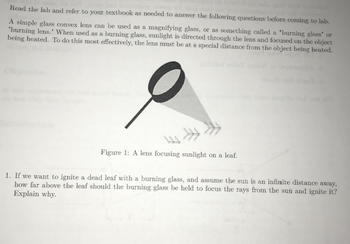
College Physics
11th Edition
ISBN: 9781305952300
Author: Raymond A. Serway, Chris Vuille
Publisher: Cengage Learning
expand_more
expand_more
format_list_bulleted
Concept explainers
Question

Transcribed Image Text:Read the lab and refer to your textbook as needed to answer the following questions before coming to lab.
A simple glass convex lens can be used as a magnifying glass, or as something called a "burning glass' or
"burning lens." When used as a burning glass, sunlight is directed through the lens and focused on the object
being heated. To do this most effectively, the lens must be at a special distance from the object being heated.
Figure 1: A lens focusing sunlight on a leaf.
1. If we want to ignite a dead leaf with a burning glass, and assume the sun is an infinite distance away,
how far above the leaf should the burning glass be held to focus the rays from the sun and ignite it?
Explain why.
Expert Solution
This question has been solved!
Explore an expertly crafted, step-by-step solution for a thorough understanding of key concepts.
This is a popular solution
Trending nowThis is a popular solution!
Step by stepSolved in 2 steps with 2 images

Knowledge Booster
Learn more about
Need a deep-dive on the concept behind this application? Look no further. Learn more about this topic, physics and related others by exploring similar questions and additional content below.Similar questions
- Use the information from the lecture on the rules for ray tracing to complete the ray tracing for the different situations below. This part is graded on completeness so just try it out even if you feel it is wrong. Notice it is important to not get confused between the rules for lenses and mirrors. 1. Consider a concave mirror. An object is placed at various object distances from the mirror. For each case, use ray tracing to determine the following characteristics of the image: * is it real or virtual? n is it upright or inverted? n is it smaller or bigger than the object (or the same size)? n where is the image located? (approximate location – does not have to be exact) Assume a concave mirror with a focal length of f=5cm. Make sure to use a ruler and follow the ray-tracing rules. Draw a diagram for each of the following cases: (a) object is at f/2 (b) object is at f (c) object is at 3f/2 (halfway between center of curvature and focal length) (d) object is at 2f (exactly at center of…arrow_forwardWhat is the focal length of a makeup mirror that produces a magnification of 1.5 when a person's face is 12.2 cm away? Think & Prepare 1. What kind of mirror causes magnification? 2. What kind of image is it? 3. What signs will the different quantities have? (a) Set-up the table for some known quantities. i) Make sure to use the correct sign for the image distances, object distances, and the focal lengths. ii) Make sure to use the correct sign for the image and object heights. Inverted object and image heights are negative. iii) Do NOT do any calculations for this section. d₁ = M= (b) What is the focal length? f= cm cmarrow_forwardPlease type the answer instead of hand writting thanksarrow_forward
- Create a ray diagram for a concave mirror that has as real image produced. include at least 3 rays of light from the object to create the image .arrow_forwardYour Question :help please answer in text form with proper workings and explanation for each and every part and steps with concept and introduction no AI no copy paste remember answer must be in proper format with all working!arrow_forward
arrow_back_ios
arrow_forward_ios
Recommended textbooks for you
 College PhysicsPhysicsISBN:9781305952300Author:Raymond A. Serway, Chris VuillePublisher:Cengage Learning
College PhysicsPhysicsISBN:9781305952300Author:Raymond A. Serway, Chris VuillePublisher:Cengage Learning University Physics (14th Edition)PhysicsISBN:9780133969290Author:Hugh D. Young, Roger A. FreedmanPublisher:PEARSON
University Physics (14th Edition)PhysicsISBN:9780133969290Author:Hugh D. Young, Roger A. FreedmanPublisher:PEARSON Introduction To Quantum MechanicsPhysicsISBN:9781107189638Author:Griffiths, David J., Schroeter, Darrell F.Publisher:Cambridge University Press
Introduction To Quantum MechanicsPhysicsISBN:9781107189638Author:Griffiths, David J., Schroeter, Darrell F.Publisher:Cambridge University Press Physics for Scientists and EngineersPhysicsISBN:9781337553278Author:Raymond A. Serway, John W. JewettPublisher:Cengage Learning
Physics for Scientists and EngineersPhysicsISBN:9781337553278Author:Raymond A. Serway, John W. JewettPublisher:Cengage Learning Lecture- Tutorials for Introductory AstronomyPhysicsISBN:9780321820464Author:Edward E. Prather, Tim P. Slater, Jeff P. Adams, Gina BrissendenPublisher:Addison-Wesley
Lecture- Tutorials for Introductory AstronomyPhysicsISBN:9780321820464Author:Edward E. Prather, Tim P. Slater, Jeff P. Adams, Gina BrissendenPublisher:Addison-Wesley College Physics: A Strategic Approach (4th Editio...PhysicsISBN:9780134609034Author:Randall D. Knight (Professor Emeritus), Brian Jones, Stuart FieldPublisher:PEARSON
College Physics: A Strategic Approach (4th Editio...PhysicsISBN:9780134609034Author:Randall D. Knight (Professor Emeritus), Brian Jones, Stuart FieldPublisher:PEARSON

College Physics
Physics
ISBN:9781305952300
Author:Raymond A. Serway, Chris Vuille
Publisher:Cengage Learning

University Physics (14th Edition)
Physics
ISBN:9780133969290
Author:Hugh D. Young, Roger A. Freedman
Publisher:PEARSON

Introduction To Quantum Mechanics
Physics
ISBN:9781107189638
Author:Griffiths, David J., Schroeter, Darrell F.
Publisher:Cambridge University Press

Physics for Scientists and Engineers
Physics
ISBN:9781337553278
Author:Raymond A. Serway, John W. Jewett
Publisher:Cengage Learning

Lecture- Tutorials for Introductory Astronomy
Physics
ISBN:9780321820464
Author:Edward E. Prather, Tim P. Slater, Jeff P. Adams, Gina Brissenden
Publisher:Addison-Wesley

College Physics: A Strategic Approach (4th Editio...
Physics
ISBN:9780134609034
Author:Randall D. Knight (Professor Emeritus), Brian Jones, Stuart Field
Publisher:PEARSON